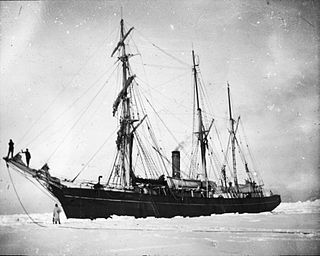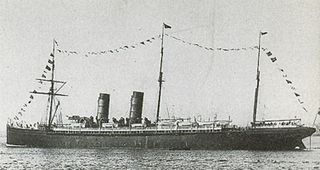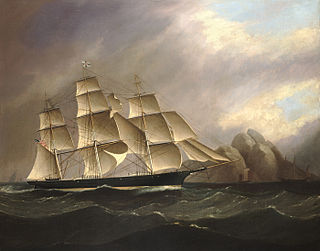
Nimrod was a wooden-hulled, three-masted sailing ship with auxiliary steam engine that was built in Scotland in 1867 as a whaler. She was the ship with which Ernest Shackleton made his Nimrod Expedition to Antarctica in 1908–09. After the expedition she returned to commercial service, and in 1919 she was wrecked in the North Sea with the loss of ten members of her crew.

Lammermuir was an extreme clipper ship built in 1864 by Pile, Spence and Company of West Hartlepool for John "Jock" "White Hat" Willis & Son, London. She was the second ship to bear the name. The first Lammermuir had been the favorite ship of John Willis, and was wrecked in the Gaspar Strait in 1863.

RMS Umbria and her sister ship RMS Etruria were the last two Cunard Line ocean liners that were fitted with auxiliary sails. Umbria as the last express steamship to be built for a North Atlantic route with a compound engine. By 1885, the triple expansion engine was the almost universal specification for newly built steamships. John Elder & Co. built Umbria in Govan, Glasgow in 1884. Umbria and her running mate Etruria were record breakers. They were the largest liners then in service, and they plied the Liverpool – New York City route. Umbria was launched by the Honourable Mrs. Hope on 25 June 1884 with wide press coverage, because she was the largest ship afloat, apart from Great Eastern, which by that time was redundant.

Queen of Nations was a wooden-hulled, three-masted clipper that was built in Scotland in 1861 and wrecked on the coast of New South Wales in 1881. She spent her entire two-decade career with George Thompson, Junior's Aberdeen White Star Line.

Belgenland was an iron-hulled sail-steamer that was launched in England in 1878 and spent most of her career as a Belgian transatlantic ocean liner. She was renamed Venere in 1904 and scrapped in Italy in 1905.
Teutonia was a screw steamer that was built by Caird & Company, Greenock, Renfrewshire, Scotland for the Hamburg Brazilianische Packetschiffahrt Gesellschaft in 1856. It later served with the Hamburg Amerika Line before being sold to British owners in 1877 and Italian owners in 1884, serving them under the names Regina, Piemontese, Città di Savona and Mentana The ship was scrapped in 1894.

SS Polar Chief was a merchant steamship that was built in England in 1897 and scrapped in Scotland in 1952. In her 55-year career she had previously been called Montcalm, RFA Crenella, Crenella, Rey Alfonso, Anglo-Norse and Empire Chief. Early in the First World War she spent eight months pretending to be the battleship HMS Audacious.

Ocean Telegraph was a clipper ship that was built in Massachusetts in 1854 and was last known of in Gibraltar in 1923. She was in US ownership until 1863, when UK interests bought her and renamed her Light Brigade.

Windsor Castle was a wooden-hulled, three-masted sailing ship that was built in England in 1857 and wrecked off the coast of Cape Colony in 1884.
Gananoque was a wood-hulled clipper ship of 785 tons, built in Quebec in 1857, that made a number of emigrant voyages to New Zealand. She had two serious collisions with icebergs in the North Atlantic, the second of which caused her loss.
Sam Cearns was a British ship-rigged sailing cargo ship and emigrant carrier, built in 1864. In 1871 she was wrecked near Tierra del Fuego after the crew members gallantly saved the crew of another windjammer Knight Errant.

PS Avalon was an iron paddle passenger vessel built on the River Thames for the Great Eastern Railway in 1864 for their ferry services from Harwich to Rotterdam and Antwerp. Before the end of that year she was bought by British interests to assist with the commissioning of the Confederate iron-clad CSS Stonewall, and renamed City of Richmond. After the war she was renamed Agnes Arkle and sold in Brazil in 1865.

Hesperus was an iron-hulled, three-masted, passenger clipper ship that was built in Scotland in 1874 and scrapped in Italy in 1923. She was built for Thompson and Anderson's Orient Line service between Great Britain and South Australia.

South Australian was a composite-hulled clipper ship that was built in Sunderland in 1868 and sank in the Bristol Channel in 1889. She was a successor to clippers St Vincent and City of Adelaide. For nearly two decades she voyaged annually between London and South Australia.

Orient was a wooden-hulled, three-masted sailing ship that was built in England in 1853 and scrapped in Gibraltar in 1925. She served in the Crimean War, and then spent two decades with James Thompson & Co's "Orient Line" of ships sailing between Great Britain and South Australia.

The Goolwa was a three-masted, composite-hulled clipper ship that was built for the trade between Great Britain and South Australia. She was built in Scotland in 1864 and sank in the Western Approaches in 1888.

The New Zealand Company was a 19th-century English company that played a key role in the colonisation of New Zealand. The company was formed to carry out the principles of systematic colonisation devised by Edward Gibbon Wakefield, who envisaged the creation of a new-model English society in the southern hemisphere. Under Wakefield's model, the colony would attract capitalists who would then have a ready supply of labour—migrant labourers who could not initially afford to be property owners, but who would have the expectation of one day buying land with their savings.

Royal Edward was an iron-hulled full-rigged ship, launched in March 1864 by Westwood, Baillie & Company at their London Yard ironworks. She was 223.5 ft (68.1 m) long, with a beam of 36.8 ft (11.2 m), and a depth of 24 ft (7.3 m).
Sea Park was a sailing ship of 835 Net register tons, completed at South Shields, England, in 1845. The ship took its name from an estate in Morayshire which the owner's brother, John Dunbar, had purchased in 1838. In 1853, the vessel undertook a contract for the British Government, transporting 305 male convicts from London to Western Australia.















